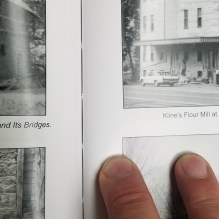Cover finishing
InstantPublisher offers many types of stock cover finishes. For special requests not listed on our site, please email or give us a call.
UV Coating
This coating is the standard “free” option on InstantPublisher’s self-published covers. UV is common in print and stands for “ultra-violet,” as the coating is dried by UV light. The coating adds a glossy sheen to the cover similar to a clear coat. It adds a little protection but not as much as plastic lamination.
Plastic lamination
Plastic lamination is a plastic film applied to book covers for a finished look that provides protection. Plastic lamination will provide some scratch resistance to your book and is an upgrade on soft cover books but comes standard on our hardcover cased books. This type of finish is recommended for any type of high use book like a cookbook or journal. The standard plastic lamination InstantPublisher offers has a gloss finish. Other types of lamination are available like antimicrobial, soft touch and matte lamination.
Linen Plastic Lamination
The linen lamination is similar to the standard gloss laminate but it is processed through a texturizer that adds a linen texture similar to an old photograph. It still has a somewhat glossy finish but not as glossy as standard gloss laminate.
Foil Stamping
Foil stamping uses a metal stamp and a foil to create a metallic finish. This type of coating is most popular on cloth or leather covers that cannot be printed on. Usually it is just a title or something small as foil has its limitations. At times, foil stamping is also used on printed material to make items stand out. Foil is available in a variety of colors but gold and silver are the most popular options.
Embossing/Debossing
Embossing/Debossing is where a stamp is made and an area of the cover is actually raised or lowered for effect. This is usually done in conjunction with print like a title or object that needs to stand out on the cover. It is similar to Foil Stamping but without the use of foil.
InstantPublisher would like to introduce a new cover coating option with antimicrobial coating technology.
Antimicrobial Coating
Instantpublisher’s antimicrobial coating offers added protection against certain dangerous bacteria and other harmful microbes. The specialty treated covers feature a durable antimicrobial coating that helps prevent the growth of some potentially harmful bacteria. Antimicrobial coating can also be cleaned with soap and water to further sanitize surfaces. This coating is ideal for use in books that are frequently handled. This coating is a gloss lamination type of coating.
Surface Treatment
In some cases, microbes such as bacteria can cause illness in humans and animals. Bacteria frequently grow on contaminated surfaces and may be transferred through physical contact. Antimicrobial coatings create a surface that helps limit certain bacterial growth. When these bacteria are unable to multiply and spread, they can easily be eliminated with common sanitation processes.
ISO-22196 Testing
Instantpublisher’s antimicrobial coating has been independently evaluated using ISO-22196 test methods to measure antibacterial activity on plastic surfaces. Antimicrobial coating has only been tested against specific bacteria and may not kill or otherwise neutralize viruses and other pathogens.
Protocol 01 -1A Testing
Antimicrobial coating has also been evaluated using Protocol 01-1A to measure the performance of sanitizers on nonporous surfaces such as polyester. Multiple wear cycles are performed with test microorganisms to determine residual antimicrobial performance.
The additional cost will be $.50 per book. The option will be located under the cover coating section of the order form. Instantpublisher can supply a small logo to place on your cover to alert buyers of the extra feature per your request.


